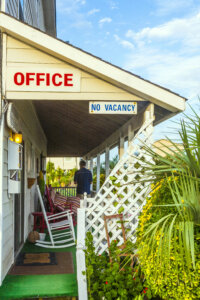Picture this: You’ve packed your RV, mapped your route, and set off for a dream adventure. Yet, when you arrive, every campground is full, leaving you scrambling for a spot. This frustration is increasingly common as RV ownership soars, intensifying competition for campsites. In this article, we’ll dive into the challenges RVers face in finding parking and campsites, explore the urgent need for better RV-friendly infrastructure, and share little-known secrets to help you snag a spot.
The Boom in RV Ownership Fuels Campsite Demand
 Firstly, RV ownership has skyrocketed in recent years, reshaping the camping landscape. According to the RV Industry Association, over 11 million households own RVs, a 62% jump since 2001. Moreover, sales surged during the COVID-19 pandemic, as families sought safe, flexible travel options. In 2023 alone, RV shipments reached 313,174 units, per RV Life, reflecting sustained enthusiasm.
Firstly, RV ownership has skyrocketed in recent years, reshaping the camping landscape. According to the RV Industry Association, over 11 million households own RVs, a 62% jump since 2001. Moreover, sales surged during the COVID-19 pandemic, as families sought safe, flexible travel options. In 2023 alone, RV shipments reached 313,174 units, per RV Life, reflecting sustained enthusiasm.
Consequently, this boom has strained campsite availability. Popular destinations like national parks saw 325.5 million visitors in 2023, many traveling by RV. As a result, campgrounds often book up months ahead, especially during summer and holidays. For RVers, this trend means planning far in advance or facing slim pickings.
Key Challenges in Finding RV Parking and Campsites
Next, let’s unpack the hurdles RVers encounter when seeking parking and campsites. Several factors complicate the search:
 Overbooked Campgrounds: High-demand spots fill quickly, often requiring bookings six months out.
Overbooked Campgrounds: High-demand spots fill quickly, often requiring bookings six months out.- Outdated Sites: Many campgrounds lack space for today’s larger RVs, with sites built for smaller rigs.
- Few Hookups: Limited electrical, water, or sewer options frustrate RVers needing full amenities.
- Remote Area Scarcity: Established campgrounds are rare in less-traveled regions, pushing RVers to adapt.
- Fierce Competition: More RVs on the road mean more campers vying for the same spots.
For instance, a 2023 survey by RV Travel found 68% of RVers struggled to find sites during peak season. Additionally, older parks like those managed by the National Park Service often can’t accommodate modern RV lengths, averaging 35-40 feet, per RV Share.
Why Campground Modernization Matters
Meanwhile, the call for campground upgrades grows louder as RVing evolves. Outdated infrastructure can’t keep pace with today’s needs. Specifically, RVers want:
- Longer, wider sites for big rigs.
- More hookups, including 50-amp electrical service.
- Better road access and site maintenance.
- Expanded capacity to ease overcrowding.
Moreover, modernizing campgrounds boosts local economies. In 2023, national park visitors spent $23.9 billion in gateway communities, per the National Park Service. Each dollar invested in parks returns over $10 to the economy, making upgrades a win-win. However, funding lags, with many federal sites relying on public-private partnerships, as noted by FMCA.
For practical tips on maintaining your RV for these trips, check out E3 Rving’s RV Maintenance Checklist.
The Push for RV-Friendly Infrastructure
Besides physical upgrades, RV-friendly infrastructure like broadband is critical. Today, 43% of RVers work remotely at least part-time, per RV Lifestyle. Reliable internet supports:
- Remote work and online schooling.
- Safety tools like weather apps and GPS.
- Easier booking through digital platforms.
Yet, many rural campgrounds lack cell service, frustrating modern campers. For example, only 60% of national park campsites offer decent coverage, per Campendium. Enhanced broadband could transform RVing, blending adventure with connectivity.
Little-Known Secrets to Secure RV Spots
Now, let’s reveal some insider tricks to outsmart the campsite crunch:
 Leverage Apps: Use Campendium or RV Parky to find hidden gems with real-time reviews.
Leverage Apps: Use Campendium or RV Parky to find hidden gems with real-time reviews.- Go Off-Peak: Camp midweek or in shoulder seasons like late fall for quieter sites.
- Join Clubs: Groups like Good Sam or Passport America unlock exclusive campgrounds and discounts.
- Boondock Smart: Bureau of Land Management (BLM) lands offer free camping—check rules first.
- Overnight Hacks: Park at Walmart or rest areas for quick stops, with permission.
Additionally, consider Harvest Hosts, a lesser-known gem. For a small fee, it connects RVers to unique stays at farms or wineries. Another secret? Call campgrounds directly—some hold unlisted spots for last-minute arrivals.
Curious about top destinations for these strategies? Visit E3 Rving’s Top RV Travel Destinations.
How E3 Rving and E3 Camping Help
Furthermore, *E3 Rving* and *E3 Camping* are game-changers for RVers. At e3rving.com, you’ll find a campground directory with user reviews, plus tips on everything from maintenance to safety. Their RV Safety Tips guide is a must-read for secure travels.
Meanwhile, e3camping.com offers bookings on private lands, perfect for escaping crowded parks. Together, these platforms simplify planning and uncover unique spots.
What’s Next for RVing?
Looking ahead, RVing trends signal more challenges—and opportunities. Firstly, ownership is diversifying, with younger families joining retirees, per Good Sam. This shift demands varied campsite options, from luxury to rustic.
Secondly, sustainability is rising. Solar-powered RVs and eco-friendly campgrounds are gaining traction, per Do It Yourself RV. Lastly, technology—like AI-driven booking tools—could ease the hunt for sites, though infrastructure must catch up.
In summary, rising RV ownership has made finding parking and campsites tougher than ever. However, with modernized campgrounds, better infrastructure, and savvy tricks, RVers can thrive. Start your RV adventure confidently today using these insights!
For more E3 Rving resources, be sure to visit: https://e3rving.com

